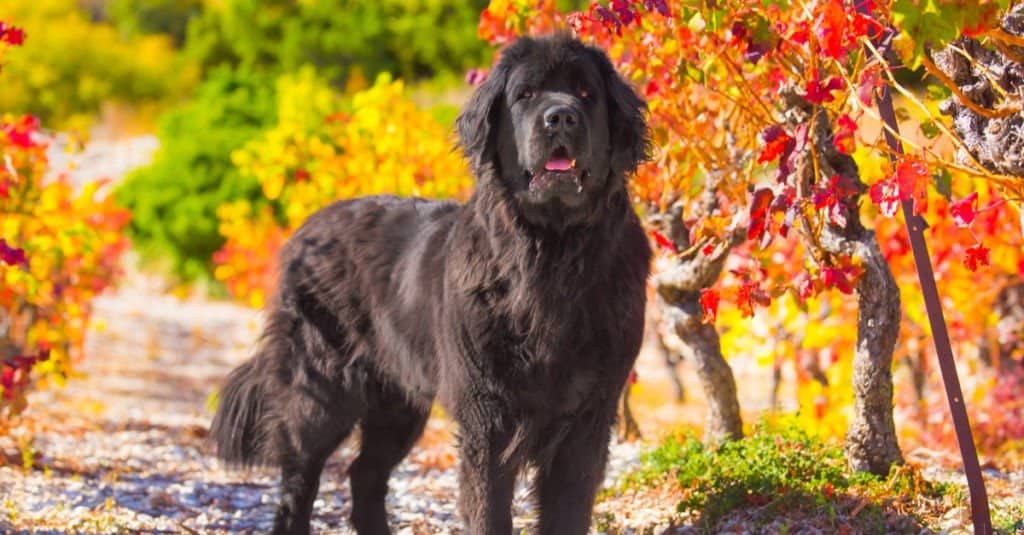The Newfoundland and Saint Bernard are two completely different breeds of dogs, with radically different appearances but nearly identical sizes. They are known for their sweet temperament and gigantic size; both animals are considered to be gentle giants. Being working dogs, they are both loyal and protective and have learned to put themselves between you and a stranger.
There are, however, key differences between these two breeds. In this article, we’ll explore all of the knowledge you might find helpful to enable you to make one of the best decisions in choosing a dog.
Let’s begin.
Comparing Newfoundland vs Saint Bernard

| Key Differences | Newfoundland | Saint Bernard |
|---|---|---|
| Size | Giant | Giant |
| Height | Male: 27-28 inches tall Female: 26 inches tall | Male: 28-30 inches tall Female: 26-28 inches tall |
| Weight | Male: 130-150 lbs Female: 100-120 lbs | Male: 180 lbs Female: 120-140 lbs |
| Coat Type | Flat, dense, coarse, and dense. | Shiny, short, dense, and slightly wavy. |
| Shedding Level | Newfoundland’s are moderate shedders. | They are heavy shedders. |
| Trainability | Easy to train. | They aren’t famous for their trainability. |
| Grooming | Grooming this breed may be too much work. | They require average grooming effort. |
| Life Expectancy | 8 to 10 years. | 8 to 10 years. |
8 Key Differences Between Newfoundland vs Saint Bernard
There are several key differences between a Newfoundland and Saint Bernard. Firstly, while both are primarily working dogs with a kind disposition, Newfoundlands were originally bred for working with fishermen in Canada while Saint Bernards were originally bred as watchdogs. The Newfoundland is a moderate shedder, while Saint Bernards are heavy shedders. Finally, the Saint Bernard is slightly larger than the Newfoundland, though they are both giant dogs.
Let’s take a closer look at these differences one by one.
Appearance and Basic Info
Newfoundland and Saint Bernard: Size

The Newfoundland is a moderate shedder, while Saint Bernards are heavy shedders.
©Pandas/Shutterstock.com
These breeds are giant muscular dogs with large heads that are wide and square. They are characterized by wrinkled brows, bushy tails, and medium-sized dropping ears. Newfoundland males come in between 27 to 28 inches and females at 26 inches, while Saint Bernard males stand between 28 to 30 inches and the females between 26 to 28 inches.
Newfoundland vs Saint Bernard: Weight
Newfoundland males weigh between 130 and 150 lbs, but females are lighter, weighing between 100 to 120 lbs. In contrast, Saint Bernard males weigh 180lbs while females weigh about 120 to 140lbs. They are both known for their intimidating size.
Newfoundland vs Saint Bernard: Coat Hair type
Newfoundland has a flat and water-resistant double coat, which helps them keep their vital organs warm during cold temperatures. The outer coat is thick and long, while the inner coat is smooth and dense.
Saint Bernard’s coat comes in two different variations: the short-haired and the long-haired coats. The short-haired is smooth but very dense and is slightly rough on the thighs. The long-haired coat has a slight wave with bushy thighs and tails. However, the short coat variety is desirable for monks of Saint Bernard’s hospice.

The Saint Bernard is slightly larger than the Newfoundland, though they are both giant dogs.
©iStock.com/Dixi_
Newfoundland vs Saint Bernard: Colors
One of the prominent features of these breeds is their colors. According to the Open Veterinary Journal, the coat color of Newfoundland may be solid black, brown, gray, or landseer, which is a combination of white and black coats. White markings can be found on the chest, toes, and tip of the tails.
Saint Bernard comes in a variety of colors and shades of red with white or white with red markings on the dog. You can find white spots at the nape of the neck, on the chest, on the feet, around the nose, and at the tip of their tails. The signature marking on the dog’s head resembles a mask preferable to lovers of Saint Bernard.
Characteristics

The Saint Bernard comes in a variety of colors, while the Newfoundland comes only in black and white colors.
©Rita_Kochmarjova/Shutterstock.com
Newfoundland vs Saint Bernard: Temperament
Although both dogs are known for their sweet temperaments, they are also attention seekers. Saint Bernard, however, is less demanding than Newfoundland. Being good-natured and warmhearted breeds, they are both patient and careful, especially towards children.
Newfoundland vs Saint Bernard: Shedding
Newfoundlands are moderate shedders and will shed more in the spring or fall. Their long thick hair requires regular brushing a few times a week to maintain the coat’s soft and thick look.
Saint Bernard’s are heavy shedders and would blow their coats twice a year. You should brush their coat daily to remove loose hair and keep the coat clean and healthy.
Newfoundland vs Saint Bernard: Trainability
Being smart dogs and eager to please, Newfoundlands are relatively easy to train. Yet, they must have a constant mental assessment. Apart from working, they are trained to participate in sports such as obedience trials, tracking, drafting, and agility, among other games.
Saint Bernards aren’t famous for their trainability, but they must be properly trained as they may be stubborn at times. They also participate in sports, just like Newfoundland.
Health Factors

Saint Bernards are less attention-seeking and demanding compared to the Newfoundland.
©Pandas/Shutterstock.com
Newfoundland vs Saint Bernard: Health Problems
These dogs are prone to certain similar health conditions. According to the American Heart Journal, Newfoundlands are affected by subaortic stenosis. They are also susceptible to Addison’s disease, eye problems, epilepsy, cancer, kidney disorders, hip dysplasia, hypothyroidism, and heart conditions.
A Saint Bernard can struggle with dilated cardiomyopathy, elbow dysplasia, cataracts, entropion, stomach issues, and heart conditions. Therefore, due to these genetic diseases and disorders, an owner needs to be aware of any sort of health problem.
Newfoundland vs Saint Bernard: Life Expectancy

Saint Bernard can live for 8 to 10 years, while Newfoundlands also live for this same amount of time.
©Rita_Kochmarjova/Shutterstock.com
An average Newfoundland can live for 8 to 10 years, while a healthy one can live for about 15 years. Saint Bernard can also live for 8 to 10 years. However, the lifespan of these dogs depends on how well you care for them. Newfoundland, Saint Bernard, and other giant breeds have shorter lifespans than smaller dogs. Adequate care and treatment should be made available to them.
Conclusion
Both breeds are good-natured, patient, and kind dogs with an affectionate personality for all members of the family, especially children. They are intelligent and, due to their intimidating size, are considered great protectors because they excel in assessing possible threats that may cause and help scare off intruders. Taking account of all these qualities, they make the best companion, and as such, a good family pet when properly trained right.
The photo featured at the top of this post is © Pandas/Shutterstock.com
Ready to discover the top 10 cutest dog breeds in the entire world?
How about the fastest dogs, the largest dogs and those that are -- quite frankly -- just the kindest dogs on the planet? Each day, AZ Animals sends out lists just like this to our thousands of email subscribers. And the best part? It's FREE. Join today by entering your email below.
Thank you for reading! Have some feedback for us? Contact the AZ Animals editorial team.






